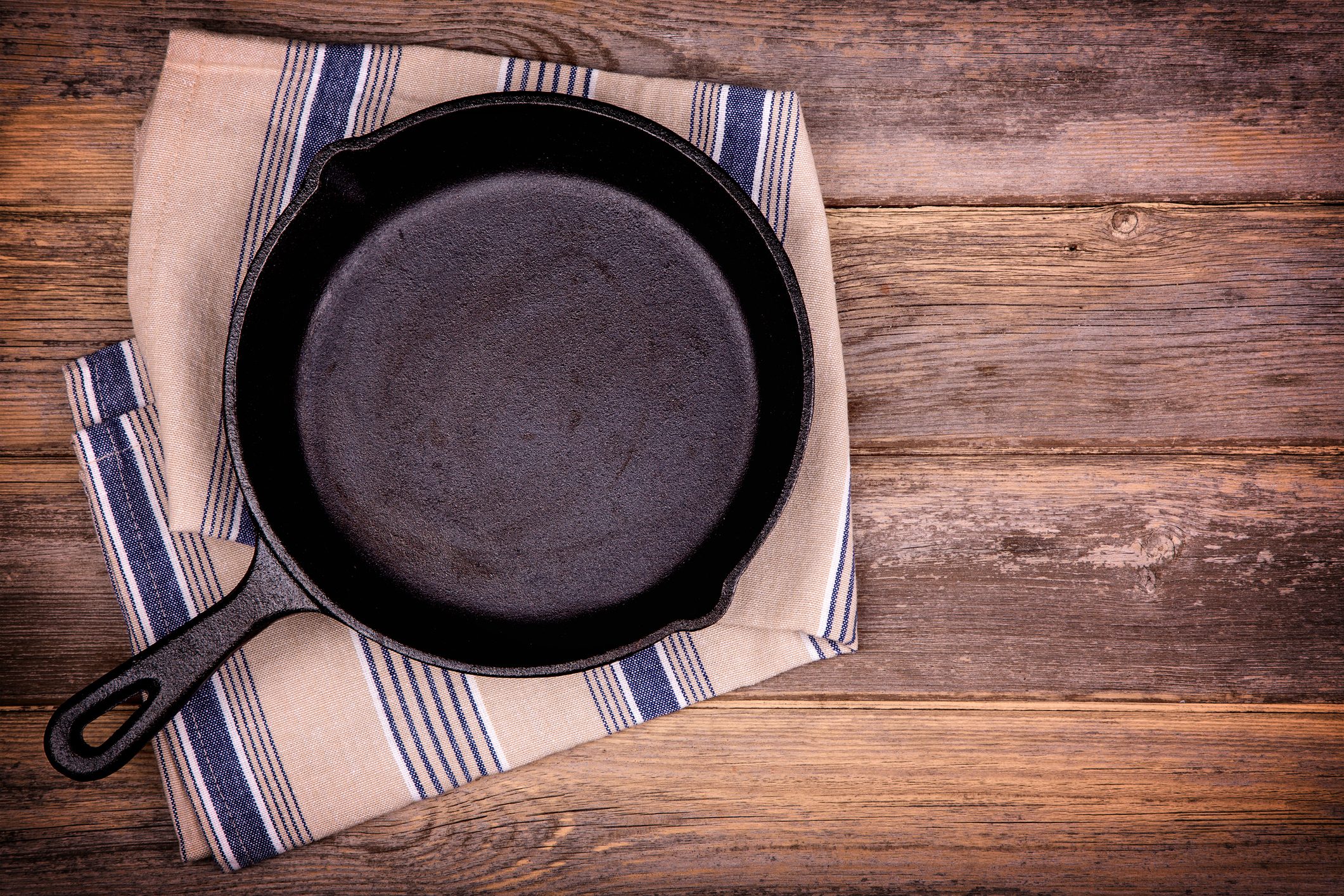How to clean a cast iron skillet or pan properly without damaging it
Knowing how to clean a cast iron skillet properly is key to keeping this essential piece of cookware at its best

Learning how to clean a cast iron skillet properly is important if you want to keep this essential piece of cookware at its best. It requires a little more love and care than you have to give to other pans since the material is easily damaged, but once you know how to do it, you'll find yourself using your best cast iron skillet on a weekly, or even daily basis.
This trusty piece of cookware is sturdy, lasts almost forever, and you don't have to worry about scratches ruining its value. Even better, taking care of a cast iron pan isn't as hard as you'd think!
Cleaning a cast iron skillet is similar to knowing how to cleaning a washing machine, how to descale a kettle, or how to clean an oven—once you do know how, it really is simple to do. But finding out the correct way to clean yours thoroughly, and without causing the pan any damage, is the key.
How to clean a cast iron skillet or pan in three simple steps
Cleaning your cast iron pan/skillet just takes a bit of know-how, similar to learning how to clean a burnt pan. As our steps below show, the key to effortless cleaning is to wash it as soon as possible after use. We've provided specific tips to remove burnt-on food, and on how to restore your cast iron to its former glory if it's looking a little worse for wear.
Much like cleaning a kitchen, following this step-by-step process will mean you can get the job done in a flash, and without too much sweating over the sink...
1. Clean your cast iron immediately after cooking
After a long, hard day, it can be hard to resist letting your pan soak while you eat dinner. Sometimes the temptation can lead to soaking your pan all night (something we often do with our best food processor, or our best blenders), but don't give in! If there is only one thing you need to know about cleaning a cast iron pan, it's to clean it as soon as possible after use, and not to let it soak for too long. Your cast iron pan is not rust-proof, so if you let it soak, it will certainly rust.
What’s more, if you have it soaking in dish soap, the porous cast iron will absorb all the scents, and nobody wants to cook on a pan that smells like perfumed dish soap.
Sign up to our free daily email for the latest royal and entertainment news, interesting opinion, expert advice on styling and beauty trends, and no-nonsense guides to the health and wellness questions you want answered.
With that being said, when you get the urge to procrastinate washing your cast iron (like most of us do), push through it and get the job done.
Ready? Here's what you need to do as soon as you've finished cooking.
2. Remove burnt food and rinse
The first thing you'll want to do when cleaning a cast iron skillet is to remove burnt food. There are a few methods to do this, but here are our recommended (and crucially, non-abrasive) techniques.:
- Use Kosher salt and paper towels - Chances are, you've been faced with an ugly, pan-seared blend of food stuck to the bottom of your pan, and not the kind that's easy to scrape off. We're talking about the kind that makes you want to throw your whole pan out. But never fear: it's something that happens to all pans—even our best induction pans, which are meant to be easier to clean. Thankfully though, there is a fairly easy solution to the problem. The easiest way to do this is to simply bunch up a piece or two of paper towel, and use Kosher salt or coarse sea salt to scrub off any remains. Add approximately one cup of kosher salt to the skillet and use the paper towels to gently scour the surface—the burnt food should start to come off fairly easily, with a little bit of force. Afterward, rinse off the salt with warm water.
- Use a wooden spoon and hot water - If you don't have salt or paper towels at hand, this method will do the trick. Before jumping into this great cleaning method, you need to know that hot water and a hot iron pan will make steam. Therefore, you need to be very alert and careful when combining the two. Additionally, don’t try to cut corners and use cold water to clean a hot cast iron pan. The difference in temperature will damage and crack the pan. You don't want to ruin your precious cast iron before you had the chance to enjoy its lifelong benefits! To get started, make sure the pan is hot itself, and gently place it under hot running water. Scrub at it (gently), with a wooden spoon—or a rubber spatula if you don't have a wooden spoon. The food and any excess dirt on your pan should rub right off. Once you've lifted them off, rinse the pan. If you let your iron cool off after cooking, don't worry. You can easily put the pan back on the stove burner to heat it back up while you're warming up your running water.
- Cook away the burnt bits - It seems counterintuitive to put a burnt pan back on the stovetop, but this is a quick way to loosen the burnt food on your skillet. To try this method, add water to your pan to about halfway then put it on medium heat. The burnt pieces will start to break away from the bottom, meaning you can easily remove them. Use a wooden spatula to gently budge them. Do not use metal utensils on the pan as this will scratch it.
3. Dry your cast iron skillet immediately
All of the above steps should clean your cast iron effectively using plain water. However, if you find that some small marks persist, feel free to use a little warm water and mild dish soap if needed and scrub it gently with a soft and non-abrasive sponge. In most situations, however, this shouldn't be necessary.
It's important you dry your cast iron pan straight after cleaning it. Use a paper towel, clean rag, or old dishcloth. It will likely stain, so avoid using a clean, new kitchen towel. Resist the temptation to leave it on the drying rack, as moisture will cause it to rust.
And voila! That's it. The key thing to remember is that you need to clean it fast, using non-abrasive techniques, and dry it quickly too.
How to remove rust from your cast iron skillet or pan
If you're anything like the majority of cast iron cooks (especially new ones), then you may have already made a mistake or two, and now your frying pan is seemingly rusty beyond repair. The good news is that it isn't! Cast iron may rust easily, but it can also be restored easily.
Much like when you clean your stainless steel sink, your cast iron pan just needs a bit of love and attention to help it look its best again.
- The solution to restoring your cast iron is to soak it in an even mixture of water and distilled vinegar for about an hour. Keep a close eye on it and rinse it out sooner if the rust has lifted.
- Then sprinkle your pan with baking soda and scrub it down with steel wool or a metal scouring pad.
- Don’t use the scented ones from the grocery store that come with detergents already in them. Just use plain steel wool.
- Keep rinsing until all the rust is off and immediately dry with a paper towel until the grime stops coming off.
- Then, bake your pan in your oven, set at 350, for about 10 minutes, to cure it.

As you may be starting to realize by now, cleaning your cast iron cookware isn't nearly as bad as you may have imagined. When you actually know how to clean a cast iron skillet/pan oven, the process can be fairly quick and easy. And when cleaned correctly, your cast iron pan can last a lifetime.
Amy Hunt is an experienced digital journalist specialising in homes, interiors and hobbies. She began her career working as the features assistant at woman&home magazine, before moving over to the digital side of the brand where she eventually became the Lifestyle Editor up until January 2022. Amy won the Digital Journalist of the Year award at the AOP Awards in 2019 for her work on womanandhome.com.
- Anna PaulFreelance editor and writer

